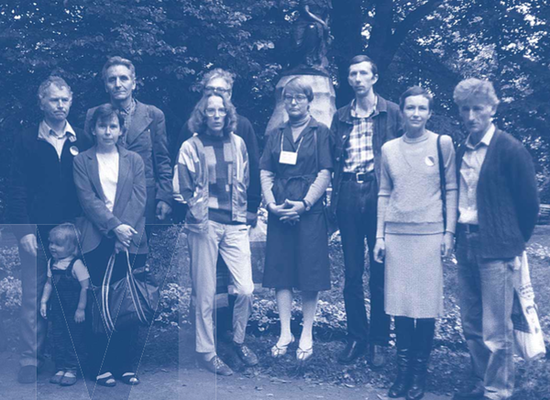40 years ago, on October 24, 1972, a Memorandum was sent from Soviet occupied Estonia to the United Nations. It was signed by two underground resistance groups - the Estonian National Front and the Estonian Democratic Movement. This initiative started the organised and peaceful fight for the restoration of the independence of the Republic of Estonia, which had been illegally occupied and annexed to the Soviet Union as a result of the 1939 Hitler-Stalin Pact.
Estonian resistance in 1970s was based on international law and UN Charter. The goal of the Memorandum was to penetrate the tight Soviet censorship to the international community that despite the massive repressions of the totalitarian regime, Estonians had not lost hope to regain freedom and are counting on the assistance of the United Nations Organisation.
The initiators of the memorandum, Mati Kiirend and Kalju Mätik, flanked by other dissidents at the subsequent key event - the first meeting at Hirvepark in August 1987. From left: Mati, Marileen and Malle Kiirend, Kalju Mätik, Maris Sarv, Jüri Adams, Lagle Parek, Arvo Pesti, Eve Pärnaste, Endel Ratas. Photo: Private collection
According to one of the initiators of the 1972 Memorandum, Tunne Kelam, the only lifeline for Estonian citizens after 27 years of Soviet dominance was the awareness that leading Western democracies still refused to recognise the Soviet annexation of the Baltic states as legal. At the same time, Estonians were deeply worried of the possibility of becoming a minority in their own land as a result of massive deportations and the introduction of huge numbers of military personnel and immigrants from the Soviet Union.
“This was a desperate message to the West sent in the full knowledge that all participants would be harshly punished just for the simple fact of openly stating their concerns,” said Kelam. “We asked for UN help to restore independence of Estonia, a former member state of the League of Nations, by introducing temporary UN administration, by evacuating Soviet occupation forces and by organising free elections to the Constituent Assembly.”
No official reply was ever sent. However, the Memorandum did reach the Western public opinion and sent a signal that many people in Estonia do not support the communist regime and continue to aspire for freedom.
Several organisers of the Memorandum were sentenced to 6 years imprisonment for “slandering” the Soviet Union, dozens were interrogated, house-searched and fired from their jobs. Still, in the Western world, an understanding started to grow that the Baltic nations deserve the same measure of freedom and democracy than all the members of the UN.
Nine years later, in January 1983, the European Parliament adopted its first resolution in support of the Baltic nations, initiated by Otto von Habsburg.






